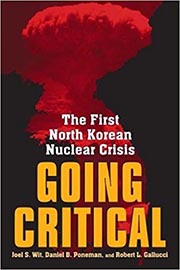Going Critical: The First North Korean Nuclear Crisis
by Joel S. Wit, Daniel B. Poneman, Robert L. Gallucci
Reviewed November 29, 2004
 In Going Critical: The First North Korean Nuclear Crisis, three former United States officials who played key roles in the nuclear crisis recount the intense efforts that led to the signing of the 1994 Agreed Framework. United States intelligence had revealed evidence of a clandestine and robust nuclear weapons program. When confronted with this knowledge, North Korea responded by announcing its intent to withdraw from the Nuclear Non-Proliferation treaty. If left unconstrained, North Korea would be able to produce approximately thirty Nagasaki-sized nuclear weapons annually. These weapons would directly threaten the United States and its allies. There were additional worries that cash-strapped North Korea might be tempted to sell these devices to other countries or terrorist groups.
In Going Critical: The First North Korean Nuclear Crisis, three former United States officials who played key roles in the nuclear crisis recount the intense efforts that led to the signing of the 1994 Agreed Framework. United States intelligence had revealed evidence of a clandestine and robust nuclear weapons program. When confronted with this knowledge, North Korea responded by announcing its intent to withdraw from the Nuclear Non-Proliferation treaty. If left unconstrained, North Korea would be able to produce approximately thirty Nagasaki-sized nuclear weapons annually. These weapons would directly threaten the United States and its allies. There were additional worries that cash-strapped North Korea might be tempted to sell these devices to other countries or terrorist groups.
This book chronicles the intense and complex web of diplomacy that led North Korea to freeze - and ultimately dismantle - its plutonium production program. Throughout the entire process there was the threat of a second Korean War. The authors explore the challenges of weaving a multi-part strategy (military, economic, and diplomatic) to resolve this crisis. Their efforts led to the negotiations that produced the 1994 Agreed Framework.
Unfortunately, the Agreed Framework now lies abandoned. Currently, North Korea claims to possess nuclear weapons, while threatening to produce more. As our current administration deals with the second North Korean Nuclear Crisis, this book provides valuable insight in to the complex process of nuclear diplomacy.